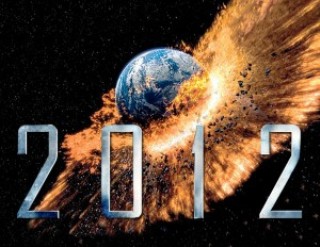
The Mayan calendar finishes one of its great cycles in December 2012, which has fueled countless theories about the end of the world on December 21, 2012 at 11:11(UTC).
Countdown to December 21, 2012, 11:11 UTC
One theory suggests a galactic alignment which would create chaos on Earth because of the gravitational effect between the Sun and the Black hole called Sagittarius A, which is located at the center of our galaxy.
Another theory involves a 'polar shift', which means a reversal of the north and south magnetic poles.
Scientists believe that the Earth is overdue for a geomagnetic reversal. However, this can take up to 5,000 years to complete and does not start on any particular date.
Just a new beginning
NASA scientists have thoroughly studied and analyzed the possibility of the Earth ending in 2012, and have concluded that 21st December 2012 will be nothing more than a normal December solstice.
There is simply no scientific evidence to support any claims of an apocalypse on Earth on December 12, 2012.
No planetary alignment
In response to theories about planetary alignments leading to an apocalypse on Earth on December 21, 2012, scientists say no planetary alignments is likely to occur in the next few decades. And even if they did, the effects on our planet would be negligible.
NASA scientists also claim that the 'polar shift' theory is totally impossible. Although continents move slowly throughout time, a magnetic reversal is very unlikely to happen in the next few millennia and would not cause any harm to life on Earth.
The scientists' conclusion is that the end of the Mayan calendar does not imply the end of the world, only the end of the Mayan long-count period. The 'long count' is a part of the Maya calendar shaped like a wheel. When we reach the end of the wheel, it will turn to the beginning again, just like our modern Gregorian calendar starts again every January 1
Question (Q): Are there any threats to the Earth in 2012? Many Internet websites say the world will end in December 2012.
Answer (A):The world will not end in 2012. Our planet has been getting along just fine for more than 4 billion years, and credible scientists worldwide know of no threat associated with 2012.
Q: What is the origin of the prediction that the world will end in 2012
A: The story started with claims that Nibiru, a supposed planet discovered by the Sumerians, is headed toward Earth. This catastrophe was initially predicted for May 2003, but when nothing happened the doomsday date was moved forward to December 2012 and linked to the end of one of the cycles in the ancient Mayan calendar at the winter solstice in 2012 -- hence the predicted doomsday date of December 21, 2012.
Q: Does the Mayan calendar end in December 2012
A: Just as the calendar you have on your kitchen wall does not cease to exist after December 31, the Mayan calendar does not cease to exist on December 21, 2012. This date is the end of the Mayan long-count period but then -- just as your calendar begins again on January 1 -- another long-count period begins for the Mayan calendar.
Q: Is NASA predicting a "total blackout" of Earth on Dec. 23 to Dec. 25
A: Absolutely not. Neither NASA nor any other scientific organization is predicting such a blackout. The false reports on this issue claim that some sort of "alignment of the Universe" will cause a blackout. There is no such alignment (see next question). Some versions of this rumor cite an emergency preparedness message from NASA Administrator Charles Bolden. This is simply a message encouraging people to be prepared for emergencies, recorded as part of a wider government preparedness campaign. It never mentions a blackout.
Q: Could planets align in a way that impacts Earth
A: There are no planetary alignments in the next few decades and even if these alignments were to occur, their effects on the Earth would be negligible. One major alignment occurred in 1962, for example, and two others happened during 1982 and 2000. Each December the Earth and sun align with the approximate center of the Milky Way Galaxy but that is an annual event of no consequence.
Q: Is there a planet or brown dwarf called Nibiru or Planet X or Eris that is approaching the Earth and threatening our planet with widespread destruction
A: Nibiru and other stories about wayward planets are an Internet hoax. There is no factual basis for these claims. If Nibiru or Planet X were real and headed for an encounter with the Earth in 2012, astronomers would have been tracking it for at least the past decade, and it would be visible by now to the naked eye. Obviously, it does not exist. Eris is real, but it is a dwarf planet similar to Pluto that will remain in the outer solar system; the closest it can come to Earth is about 4 billion miles.
Q: What is the polar shift theory? Is it true that the Earth's crust does a 180-degree rotation around the core in a matter of days if not hours
A: A reversal in the rotation of Earth is impossible. There are slow movements of the continents (for example Antarctica was near the equator hundreds of millions of years ago), but that is irrelevant to claims of reversal of the rotational poles. However, many of the disaster websites pull a bait-and-switch to fool people. They claim a relationship between the rotation and the magnetic polarity of Earth, which does change irregularly, with a magnetic reversal taking place every 400,000 years on average. As far as we know, such a magnetic reversal doesn’t cause any harm to life on Earth. Scientists believe a magnetic reversal is very unlikely to happen in the next few millennia.
Q: Is the Earth in danger of being hit by a meteor in 2012
A: The Earth has always been subject to impacts by comets and asteroids, although big hits are very rare. The last big impact was 65 million years ago, and that led to the extinction of the dinosaurs. Today NASA astronomers are carrying out a survey called the Spaceguard Survey to find any large near-Earth asteroids long before they hit. We have already determined that there are no threatening asteroids as large as the one that killed the dinosaurs. All this work is done openly with the discoveries posted every day on the NASA Near-Earth Object Program Office website, so you can see for yourself that nothing is predicted to hit in 2012.
Q: How do NASA scientists feel about claims of the world ending in 2012
A: For any claims of disaster or dramatic changes in 2012, where is the science? Where is the evidence? There is none, and for all the fictional assertions, whether they are made in books, movies, documentaries or over the Internet, we cannot change that simple fact. There is no credible evidence for any of the assertions made in support of unusual events taking place in December 2012.
Q: Is there a danger from giant solar storms predicted for 2012
A: Solar activity has a regular cycle, with peaks approximately every 11 years. Near these activity peaks, solar flares can cause some interruption of satellite communications, although engineers are learning how to build electronics that are protected against most solar storms. But there is no special risk associated with 2012. The next solar maximum will occur in the 2012-2014 time frame and is predicted to be an average solar cycle, no different than previous cycles throughout history.












